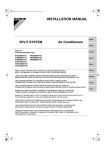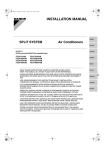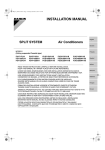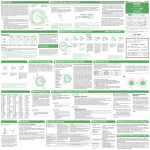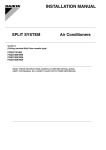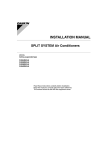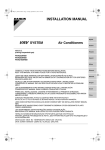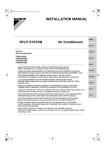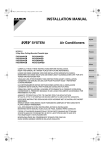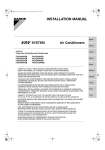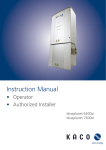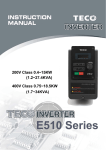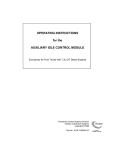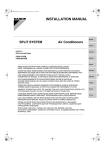Download INSTALLATION MANUAL - daikin tech.co. uk
Transcript
00_CV_3P249378-3C.fm Page 1 Thursday, August 26, 2010 7:33 PM INSTALLATION MANUAL SPLIT SYSTEM Air Conditioners MODELS (Ceiling suspension type) FHQG71CVEB FHQG100CVEB FHQG125CVEB FHQG140CVEB READ THESE INSTRUCTIONS CAREFULLY BEFORE INSTALLATION. KEEP THIS MANUAL IN A HANDY PLACE FOR FUTURE REFERENCE. 01_EN_3P249378-3C.fm Page 1 Thursday, August 26, 2010 9:55 PM FHQG71CVEB FHQG100CVEB FHQG125CVEB FHQG140CVEB SPLIT SYSTEM Air Conditioner Installation manual CONTENTS 1. SAFETY PRECAUTIONS .............................................................................................. 1 2. BEFORE INSTALLATION .............................................................................................. 3 3. SELECTING INSTALLATION SITE ............................................................................... 5 4. PREPARATIONS BEFORE INSTALLATION................................................................. 6 5. INDOOR UNIT INSTALLATION ..................................................................................... 8 6. REFRIGERANT PIPING WORK .................................................................................... 9 7. DRAIN PIPING WORK................................................................................................. 13 8. ELECTRIC WIRING WORK ......................................................................................... 15 9. WIRING EXAMPLE ...................................................................................................... 19 10. ATTACHING THE SUCTION GRILLE AND THE DRESSING BOARDS..................... 22 11. FIELD SETTINGS ........................................................................................................ 22 12. TEST OPERATION ...................................................................................................... 23 13. WIRING DIAGRAM ...................................................................................................... 27 1. SAFETY PRECAUTIONS Please read these “SAFETY PRECAUTIONS” carefully before installing air conditioning equipment and be sure to install it correctly. After completing installation, conduct a trial operation to check for faults and explain to the customer how to operate the air conditioner and take care of it with the aid of the operation manual. Ask the customer to store the installation manual along with the operation manual for future reference. This air conditioner comes under the term “appliances not accesible to the general public”. Meaning of WARNING and CAUTION notices. WARNING ........Failure to follow these instructions properly may result in personal injury or loss of life. CAUTION ..........Failure to observe these instructions properly may result in property damage or personal injury, which may be serious depending on the circumstances. WARNING • Ask your dealer or qualified personnel to carry out installation work. Do not attempt to install the air conditioner yourself. Improper installation may result in water leakage, electric shocks or fire. • Install the air conditioner in accordance with the instructions in this installation manual. Improper installation may result in water leakage, electric shocks or fire. • Be sure to use only the specified accessories and parts for installation work. Failure to use the specified parts may result in the unit falling, water leakage, electric shocks or fire. English 1 01_EN_3P249378-3C.fm Page 2 Thursday, August 26, 2010 9:55 PM • When installing the unit in a small room, take measures against to keep refrigerant concentration from exceeding allowable safety limits in the event of refrigerant leakage. Contact the place of purchase for more information. Excessive refrigerant in a closed ambient can lead to oxygen deficiency. • Install the air conditioner on a foundation strong enough to withstand the weight of the unit. A foundation of insufficient strength may result in the equipment falling and causing injury. • Carry out the specified installation work after taking into account strong winds, typhoons or earthquakes. Failure to do so during installation work may result in the unit falling and causing accidents. • Make sure that a separate power supply circuit is provided for this unit and that all electrical work is carried out by qualified personnel according to local laws and regulations and this installation manual. An insufficient power supply capacity or improper electrical construction may lead to electric shocks or fire. • Make sure that all wiring is secured, the specified wires are used, and that there is no strain on the terminal connections or wires. Improper connections or securing of wires may result in abnormal heat build-up or fire. • When wiring the power supply and connecting the wiring between the indoor and outdoor units, position the wires so that the control box lid can be securely fastened. Improper positioning of the control box lid may result in electric shocks, fire or overheating terminals. • If refrigerant gas leaks during installation, ventilate the area immediately. Toxic gas may be produced if the refrigerant comes into contact with fire. • After completing installation, check for refrigerant gas leakage. Toxic gas may be produced if the refrigerant gas leaks into the room and comes into contact with a source of fire, such as a fan heater, stove or cooker. • Be sure to switch off the unit before touching any electrical parts. • Be sure to earth the air conditioner. Do not earth the unit to a utility pipe, lightning conductor or telephone earth lead. Imperfect earthing may result in electric shocks or fire. A high surge current from lightning or other sources may cause damage to the air conditioner. • Be sure to install an earth leakage breaker. Failure to install an earth leakage breaker may result in electric shocks or fire. • Do not directly touch refrigerant that has leaked from refrigerant pipes or other areas, as there is a danger of frostbite. • CAUTION While following the instructions in this installation manual, install drain piping to ensure proper drainage and insulate piping to prevent condensation. Improper drain piping may result in indoor water leakage and property damage. Install the indoor and outdoor units, power cord and connecting wires at least 1 meter away from televisions or radios to prevent picture interference and noise. (Depending on the incoming signal strength, a distance of 1 meter may not be sufficient to eliminate noise.) Remote controller (wireless kit) transmitting distance can be shorter than expected in rooms with electronic fluorescent lamps (inverter or rapid start types). Install the indoor unit as far away from fluorescent lamps as possible. Do not install the air conditioner in the following locations: 1. Where there is a high concentration of mineral oil spray or vapour (e.g. a kitchen). Plastic parts will deteriorate, parts may fall off and water leakage could result. 2. Where corrosive gas, such as sulphurous acid gas, is produced. Corroding of copper pipes or soldered parts may result in refrigerant leakage. 3. Near machinery emitting electromagnetic radiation. Electromagnetic radiation may disturb the operation of the control system and result in a malfunction of the unit. 4. Where flammable gas may leak, where there is carbon fibre or ignitable dust suspensions in the air, or where volatile flammables such as paint thinner or gasoline are handled. Operating the unit in such conditions may result in fire. The air conditioner is not intended for use in a potentially explosive atmosphere. 2 English • • • • 01_EN_3P249378-3C.fm Page 3 Thursday, August 26, 2010 9:55 PM 2. BEFORE INSTALLATION Do not exert pressure on the resin parts when opening the unit or when moving it after opening. Be sure to check the type of R410A refrigerant to be used before doing any work. (Using an incorrect refrigerant will prevent normal operation of the unit.) • When moving the unit while removing it from the carton box, be sure to lift it by holding on to the four lifting lugs without exerting any pressure on other parts, especially swing flap, the refrigerant piping, drain piping, and other resin parts. • The accessories needed for installation must be retained in your custody until the installation work is completed. Do not discard them! After the indoor unit is delivered, protect the unit using packaging material until the installation so that it is not scratched. • Decide upon a line of transport. • Leave the unit inside its packaging while moving, until reaching the installation site. Where unpacking is unavoidable, use a sling of soft material or protective plates together with a rope when lifting, to avoid damage or scratches to the unit. • When selecting installation site, refer to the paper pattern. • For the installation of an outdoor unit, refer to the installation manual attached to the outdoor unit. • Do not use the unit in locations with high salt content in the air such as beachfront property, locations where the voltage fluctuates such as factories, or in automobiles or marine vessels. 2-1 ACCESSORIES Check the following accessories are included with your unit. Do not dispose of any parts necessary for installation until the installation is completed. Name 1) Drain hose 2) Metal clamp 3) Washer for hanger bracket 4) Clamp 5) Paper pattern for installation Quantity 1 pc. 1 pc. 8 pcs. 7 pcs. 1 pc. Shape Name Quantity Shape Insulation for fitting Sealing pad 1 each. 1 each. 6)For gas pipe 8) Large 7)For liquid pipe 9) Small 10) Bushing 1 pc. 11) Fixture 2 pcs. 12) Screw thread (M4) 2 pcs. (Other) • Operation manual • Installation manual • Declaration of conformity 2-2 OPTIONAL ACCESSORIES • The remote controller are required for this indoor unit “Table 1”. • These are two types of remote controllers: wired and wireless. Select a remote controller from “Table 1” according to customer request and install in an appropriate place. Table 1 Wired type Wireless type BRC1E51A7, BRC1D528 BRC7G63 NOTE • If you wish to use a remote controller that is not listed in “Table 1”, select a suitable remote controller after consulting catalogs and technical materials. English 3 01_EN_3P249378-3C.fm Page 4 Thursday, August 26, 2010 9:55 PM FOR THE FOLLOWING ITEMS, TAKE SPECIAL CARE DURING CONSTRUCTION AND CHECK AFTER INSTALLATION IS FINISHED. a. Items to be checked after completion of work Items to be checked Are the indoor and outdoor unit fixed firmly? Is the installation unit and the outdoor unit completed? Is the gas leak test finished? Is the unit fully insulated? Does drainage flow smoothly? Does the power supply voltage correspond to that shown on the name plate? Are wiring and piping correct? Is the unit safely grounded? Is wiring size according to specifications? Is something blocking the air outlet or inlet of either the indoor or outdoor units? Are refrigerant piping length and additional refrigerant charge noted down? If not properly done, what is likely to occur The units may drop, vibrate or make noise. The unit may malfunction or the components burn out. It may result in insufficient cooling. Condensate water may drip. Condensate water may drip. The unit may malfunction or the components burn out. The unit may malfunction or the components burn out. It may result in electric shock. The unit may malfunction or the components burn out. Check It may result in insufficient cooling. The refrigerant charge in the system is not clear. b. Items to be checked at time of delivery ∗ Also review the “SAFETY PRECAUTIONS” Items to be checked Check Has the field setting done (as necessary)? Did you attach the control box lid, air filter, and suction grille? Does the cold air (warm air) blow properly during the cooling (heating) operation? Did you explain about operations while showing the instruction manual to your customer? Did you hand the instruction manual over to your customer? c. Points for explanation about operations The items with WARNING and CAUTION marks in the instruction manual are the items pertaining to possibilities for bodily injury and material damage in addition to the general usage of the product. Accordingly, it is necessary that you make a full explanation about the described contents and also ask your customers to read the instruction manual. 2-3 NOTE TO THE INSTALLER Be sure to instruct customers how to properly operate the unit (especially cleaning filters, operating different functions, and adjusting the temperature) by having them carry out operations themselves while looking at the manual. 4 English 01_EN_3P249378-3C.fm Page 5 Thursday, August 26, 2010 9:55 PM 3. SELECTING INSTALLATION SITE (1) Select an installation site where the following conditions are fulfilled and that meets your customer’s approval. • Where optimum air distribution can be ensured. • Where nothing blocks air passage. • Where condensate can be properly drained. • Where the ceiling is strong enough to bear the indoor unit weight. (Due to the insufficient strength of the ceiling, the indoor unit may vibrate and come in contact with the ceiling, and this causes a buzzing noise.) • Where the false ceiling is not noticeably on an incline. • Where there is no risk of flammable gas leakage. • Where sufficient clearance for maintenance and service can be ensured. ∗≥30 ∗≥30 Air discharge Required service space Air inlet Obstruction Floor ≥300 NOTE • If there is space left over in the ∗ section, opening it up 200 mm will make servicing easier. 2500 or higher from the floor For installation in high places (Length : mm) • Where piping between indoor and outdoor units is possible within the allowable limit. (Refer to the installation manual for the outdoor unit.) CAUTION • Install the indoor and outdoor units, power cord and connecting wires at least 1 meter away from televisions or radios in order to prevent image interference or noise. (Depending on the radio waves, a distance of 1 meter may not be sufficient enough to eliminate the noise.) • When the wireless kit is installed, the remote controller transmitting distance may be shorter than expected in rooms with electronic fluorescent lamps (inverter or rapid start types). Install the indoor unit as far away from fluorescent lamps as possible. (2) Use suspension bolts for installation. Check whether the ceiling is strong enough to support the weight of the unit or not. If there is a risk, reinforce the ceiling before installing the unit. (Installation pitch is marked on the paper pattern for installation. Refer to it to check for points requiring reinforcing.) (3) The maximum ceiling height for installation is 3.5 m for unit type 71 and 4.3 m for unit type 100, 125 and 140. English 5 01_EN_3P249378-3C.fm Page 6 Thursday, August 26, 2010 9:55 PM 4. PREPARATIONS BEFORE INSTALLATION (1) Relation of holes for indoor unit, suspension bolt position, piping and wiring. G H 5 175 200 J Front view 690 (Indoor unit) 260 (Suspension bolt pitch) 210 False ceiling view 189 163 87 A (Indoor unit) B (Suspension bolt pitch) C D E 30 Rear side piping hole(φ100) Rear wire lead-in hole Left side piping hole Top side drain piping hole Top gas piping hole Top liquid piping hole Suspension bolt (×4) Top wire lead-in hole F Air outlet (Length : mm) Model Type 71 Type 100, 125, 140 A 1270 1590 B 1230 1550 C 533 693 D 479 639 E 425 585 F 530 690 G 553 713 H 532 692 J 415 575 (2) Make holes for suspension bolts, refrigerant and drain piping, and wiring. • Refer to the paper pattern for installation. • Select the location for each of holes and open the holes in the ceiling. (3) Remove the parts from the indoor unit. (3-1)Detach the suction grille. • Slide the locking knobs (×3) on the suction grille inward (direction of arrows) and lift upwards. (Refer to Fig. 1) • With the suction grille open, remove the suction grille forward, holding on to the rear tabs on the suction grille. (Refer to Fig. 2) Fig. 1 Locking knobs 6 Fig. 2 Rear tabs Suction grille English 01_EN_3P249378-3C.fm Page 7 Thursday, August 26, 2010 9:55 PM (3-2)Remove the dressing boards (left and right). • After removing the securing screws for the dressing boards (one each), pull them forward (in the direction of the arrow) and remove them. (Refer to Fig. 3) • Take out the accessories. • Make a dowel hole on the wiring lead-in side on the rear-facing or upward-facing, and then install the bushing (10) provided. Fig. 3 Accessories Dressing board securing screw (M4) < How to remove dowel hole > Bushing (10) Removable part (accessory) (for leading in from the upward-facing) Removable part (for leading in from the rear-facing) Bushing (10) (accessory) Dressing board (3-3)Remove the hanger brackets. • Loosen the 2 bolts (M8) used to attach the hanger brackets which are on each side (4 places left and right) to within 10 mm. (Refer to Fig. 4. 5) • After removing the securing screws (M5) for the hanger brackets which are on the rear side, pull the hanger brackets back (in the direction of the arrow), and remove them. (Refer to Fig. 5) Fig. 4 Fig. 5 Hanger bracket fixing screw (M5) Length of loosening should be less than 10 mm ≤10 Indoor unit Hanger bracket Hanger bracket setting bolt (M8) (Loosen) Hanger bracket CAUTION Do not remove the tape (translucent white) attached to the outside of the indoor unit. (Penetration of water may result in electrical shock or fire.) (4) Attach the suspension bolts. (Use suspension bolts which are M8-M10 in size.) • Adjust the distance of the suspension bolts from the ceiling in advance. (Refer to Fig. 6) NOTE • Use a hole-in anchor for existing ceilings, and a sunken insert, sunken anchor or other field supplied parts for new ceilings to reinforce the ceiling to bear the weight of the unit. Adjust clearance from the ceiling before proceeding further. Fig. 6 Ceiling slab 25-55 Anchor Suspension bolt False ceiling (Length : mm) All the above parts are field supplied. CAUTION If the suspension bolts are too long, the indoor unit or optional accessories may be damaged or break down. English 7 01_EN_3P249378-3C.fm Page 8 Thursday, August 26, 2010 9:55 PM 5. INDOOR UNIT INSTALLATION It may be easier to attach accessory parts before installing the indoor unit. Therefore, please also read the instruction manuals which are provided with the accessory parts. As for the parts to be used for installation work, be sure to use the provided accessories and specified parts designated by our company. (1) Secure the hanger brackets to the suspension bolts. (Refer to Fig. 7) NOTE • To ensure they are safely secured, use the included washers, and secure them with double nuts to make sure. (2) Lift the indoor unit’s main body, insert the bolts (M8) for the hanger brackets into the attachment part on the hanger brackets, while sliding the main body from the front. (Refer to Fig. 8) (3) Replace the screws for the hanger brackets which had been removed (M5) securely in 2 places left and right. This is necessary to prevent any forward and back slide in the main body of the indoor unit. (Refer to Fig. 8) (4) Fasten the bolts for the hanger brackets (M8) securely in 4 places, left and right. (Refer to Fig. 8) Fig. 7 Fig. 8 Hanger bracket Attachment part Nut (Field supplied) Washer (3) (accessory) Double nuts (Field supplied) Hanger bracket Reinforcing plate (left/right) When carrying the unit, do not hold the reinforcing plates. Hanger bracket setting bolt (M8) Hanger bracket fixing screw (M5) (5) When hanging the indoor unit main body, be sure to use a level or a plastic tube with water in it to make sure the drain piping is set either level or slightly tilted, in order to ensure proper drainage. (Refer to Fig. 9) Fig. 9 A A.B ≤ 1˚ ≤ 1˚ B ≤ 1˚ A.When the drain piping is tilted to the right, or to the right and back. Place it level, or tilt it slightly to the right or the back. (Within 1°.) B.When the drain piping is tilted to the left, or to the left and back. Place it level, or tilt it slightly to the left or the back. (Within 1°.) CAUTION Setting the unit at an angle opposite to the drain piping might cause a water leakage. 8 English 01_EN_3P249378-3C.fm Page 9 Thursday, August 26, 2010 9:55 PM 6. REFRIGERANT PIPING WORK 〈For refrigerant piping of outdoor units, see the installation manual attached to the outdoor unit.〉 〈Execute heat insulation work completely on both sides of the gas piping and the liquid piping. Otherwise, a water leakage can result sometimes.〉 (When using a heat pump, the temperature of the gas piping can reach up to approximately 120°C, so use insulation which is sufficiently resistant.) 〈Also, in cases where the temperature and humidity of the refrigerant piping sections might exceed 30°C or RH80 %, reinforce the refrigerant insulation. (20 mm or thicker) Condensation may form on the surface of the insulating material.〉 〈Before refrigerant piping work, check which type of R410A refrigerant is used. Proper operation is not possible if the types of refrigerant are not the same.〉 • • • • • CAUTION Use a pipe cutter and flare suitable for the type of R410A refrigerant. Apply ester oil or ether oil around the flare section before connecting. Make sure to use the flare nut provided with the main unit. Using other flare nuts may cause refrigerant leakage. To prevent dust, moisture or other foreign matter from infiltrating the tube, either pinch the end or cover it with tape. Do not allow anything other than the designated refrigerant to get mixed into the refrigerant circuit, such as air, etc. If any refrigerant gas leaks while working on the unit, ventilate the room thoroughly right away. • Before performing refrigerant piping work, install the stay (reinforcing plate) used for packaging and transporting. • The outdoor unit is charged with refrigerant. • Be sure to use both a spanner and torque wrench together, as shown in the drawing, when connecting or disconnecting pipes to/from the unit. (Refer to Fig. 10) • Refer to “Table 2” for the dimensions of flare nut spaces. • When connecting the flare nut, coat the flare section (both inside and outside) with ester oil or ether oil, rotate three or four times first, then screw in. (Refer to Fig. 11) Fig. 10 Torque wrench Piping union Flare nut Spanner Fig. 11 CAUTION • Overtightening may damage the flare and cause a refrigerant leakage. • Do not let oil get on the screw holders on the dressing board. Oil can weaken the screw holders. Ester oil or ether oil Table 2 Flare dimensions A (mm) φ15.9(5/8”) 61.8-75.4 N • m 45˚±2 ˚ 32.7-39.9 N • m 12.8 – 13.2 19.3 – 19.7 R0.4-0.8 A φ9.5(3/8”) Flare FHQG-CVEB 90˚±2˚ Applicable model Pipe size Tightening torque CAUTION Be careful not to damage the flare section. • Refer to “Table 2” to determine the proper tightening torque. English 9 01_EN_3P249378-3C.fm Page 10 Thursday, August 26, 2010 9:55 PM Not recommendable but in case of emergency You must use a torque wrench but if you are obliged to install the unit without a torque wrench, you may follow the installation method mentioned below. After the work is finished, make sure to check that there is no gas leak. When you keep on tightening the flare nut with a spanner, there is a point where the tightening torque suddenly increases. From that position, further tighten the flare nut the angle shown below: Unless followed the tightening instruction (it is loose tightening), it will lead to the refrigerant leakage (slow leak) and the device malfunction (it does not sufficiently cool or heat). Pipe size φ9.5 (3/8”) φ15.9 (5/8”) Further tightening angle 60 to 90 degrees 30 to 60 degrees Recommended arm length of tool Approx. 200mm Approx. 300mm • Make absolutely sure to execute heat insulation works on the pipe-connecting section after checking gas leakage by thoroughly studying the following figure and using the attached heat insulating materials for fitting (6) and (7). (Fasten both ends with the clamps (4).) (Refer to Fig. 12) • Wind the sealing pad (small) (9) around insulation for the fitting (6) only on the gas piping side. (Refer to Fig. 12) • Orient the insulating material for fitting (6) and (7) while facing it upward. CAUTION Be sure to insulate any field piping all the way to the piping connection inside the unit. (Any exposed piping may cause condensation or burns if touched.) 10 English 01_EN_3P249378-3C.fm Page 11 Thursday, August 26, 2010 9:55 PM Fig. 12 Procedure for thermal insulation of gas-side piping Insulating material for joints (6) (accessory) Piping insulation Flare nut connection material (main unit) Orient so that the end of the wrapped insulation Attach to base material is facing up Wind around the pipe, beginning at the base. Small seal material (9) (accessory) Main unit Piping insulation material (Locally procured) Clamp (4) (accessory) Insulation for gas pipe (6) (accessory) Gas piping Liquid piping Insulation for liquid pipe (7) (accessory) Clamp (4) (accessory) (× 4) Attach to the bottom (For both gas piping and liquid piping) Procedure for thermal insulation of liquid-side piping Insulating material for joints (7)(accessory) Flare nut connection Orient so that the end of the wrapped insulation material is facing up Piping insulation material (main unit) Attach to base Main unit Piping insulation material (Locally procured) Clamp (4) (accessory) <Method of connecting piping> (1) For piping facing back. • Remove the rear penetration lid and set the piping. (Refer to Fig. 13.15) (2) For piping facing up. • When setting the piping to face up, the L-shaped branch piping kit sold separately is required. • Removing the top penetration lid and use the L-shaped branch piping kit sold separately to set the piping. (Refer to Fig. 13.14) (3) For piping facing right. • Remove the stay (reinforcing plate) used for packaging and transporting on the right side, and return the screws to the original positions in the main unit. (Refer to Fig. 15) It is not necessary to install the stay (reinforcing plate) used for packaging and transporting that was removed. • Cut out a slit hole on the dressing board (right) and set the piping. (Refer to Fig. 15) English 11 01_EN_3P249378-3C.fm Page 12 Thursday, August 26, 2010 9:55 PM Fig. 13 Fig. 14 Top plate Cut out Upward-facing refrigerant piping L-shaped branch piping kit (Optional accessories) Rear penetration lid Top penetration lid Cut out Fig. 16 Fig. 15 Return the screw to the main unit. Thermistor lead line Top penetration lid clamp section Dressing board (right) removable part Swing motor lead line Rear-facing refrigerant piping Rear right-facing drain piping Right-facing refrigerant piping If the drain piping is installed on the right side, cut this section only. Stay used for Right-facing drain piping packaging and transporting (reinforcing plate) * When piping is complete, cut the removed penetration lid into the shape of the piping using scissors and attach. As when before removing the top penetration lid, secure the lead lines for the swing motor and thermistor by passing them through the clamp section on the top penetration lid. (Refer to Fig. 13.17) * When doing this, block any gaps between the piping penetration lid and the pipes using putty to prevent dust from entering the indoor unit. However, before running the piping and wiring for the remote controller through the same hole, complete “8. ELECTRIC WIRING WORK” and then fill the gap between the penetration lid and piping. • When brazing the refrigerant piping, only begin brazing (note 3) after carrying out nitrogen exchange (note 1) or while injecting nitrogen into the refrigerant piping (note 2). Once this is done, connect the indoor unit with the flared connection. (Refer to Fig. 17) Pressure-reducing valve Refrigerant piping Part to be brazed Taping hands valve Nitrogen Nitrogen Fig. 17 NOTE 1. For the nitrogen exchange procedures, please refer to the Multi-split Type Series for Building Installation manual (contact your Daikin dealer). 2. Nitrogen should be set to 0.02MPa with a pressure-reducing valve if brazing while inserting nitrogen into the piping. 12 English 01_EN_3P249378-3C.fm Page 13 Thursday, August 26, 2010 9:55 PM 3. Do not use flux when brazing refrigerant piping. Therefore, use the phosphor copper brazing filler metal (BCuP-2: JIS Z 3264/B-Cu93P-710/795: ISO 3677) which does not require flux. (Flux has extremely harmful influence on refrigerant piping systems. For instance, if the chlorine based flux is used, it will cause pipe corrosion or, in particular, if the flux contains fluorine, it will damage the refrigerant oil.) 4. When the airtight test is performed for the indoor unit and inter-unit piping after indoor unit installation, be sure to refer to the installation manual for the indoor unit or technical guide for airtight pressurization and refrigerant piping installation. 5. If the refrigerant functions inefficiently due to a failure to perform air purge and additional refrigerant filling, the devices may malfunction (no cooling or heating, etc.). Please refer to the installation manual for the indoor unit and technical guide for the refrigerant piping installation. CAUTION Do not use anything such as the oxidation inhibitor when brazing. (Residues may result in the clogging pipe or parts damage.) 7. DRAIN PIPING WORK (1) Carry out the drain piping. • Make sure piping provides proper drainage. • You can select whether to bring the drain piping our from the rear right, right, rear left, or left. For rear rightfacing and right-facing situations, refer to Fig. 15 for rear left-facing and left-facing situations. (Refer to Fig. 18) Fig. 18 Rear side (metal plate) removable part Rear left-facing drain piping Left dressing board removable part Left-facing drain piping • When setting piping facing left, move the rubber stopper and insulation which are attached to the drain pipe connection hole on the left side of the indoor unit to the right-side drain pipe connection hole. When doing this, insert the rubber stopper all the way in to prevent a water leakage. After the drain hose installing, attach the protection net by reversing the steps taken to remove it. (Refer to Fig. 19) • Make sure the pipe diameter is the same or bigger than the branch piping. (vinyl-chloride piping, nominal diameter 20 mm, external diameter 26 mm) • Make sure the piping is short, has at least a 1/100 slope, and can prevent air pockets from forming. (Refer to Fig. 20) Fig. 19 Fig. 20 Wrong Good 1 - 1.5m Protection net Protection fixing screw net Support parts Downward slope of least 1/100 or greater Do not lift Make sure there is no slack Make sure it is not in the water CAUTION Water accumulating in the drain piping can cause the drain to clog. English 13 01_EN_3P249378-3C.fm Page 14 Thursday, August 26, 2010 9:55 PM • Be sure to use the included drain hose (1) and metal clamp (2). Also, insert the drain hose completely into the drain socket, and securely attach the clamp bracket inside on the inserted tip of the drain hose. (Refer to Fig. 21. 22) (Install the metal clamp (2) as shown in the picture so that the tightening section is within about a 45 degree range.) (Do not allow the drain socket to come in contact with the drain hose. If they contact each other, maintenance operations cannot be performed for the heat exchanger, etc.) • Bend the end of the metal clamp (2) so that the sealing pad does not bulge. (Refer to Fig. 22) • When performing insulation, wind the large sealing pad (8) provided starting from the base of the metal clamp (2) and drain hose (1) in the direction of the arrow. (Refer to Fig. 21. 22) Fig. 21 Metal clamp (2) (accessory) Drain hose (1) (accessory) Sealing pad (8) (accessory) Fig. 23 To prevent condensation, do not leave any gap. Wrong Fig. 22 App Clamp area rox. Sealing pad (8) (accessory) Winding direction Metal clamp (2) (accessory) 45˚ Drain hose (1) (accessory) Use some kind of tool to bend it so the seal does not bulge. Ensure the drain pan is not punctured. Sealing pad (8) (accessory) Appro x. 45˚ < Facing rear right or right > ˚ x. 45 ppro A Metal clamp (2) (accessory) Drain hose (1) (accessory) Sealing pad (8) (accessory) < Facing rear Driver insertion left or left > (Length : mm) direction • Be sure to insulate all drain piping running indoors. • Do not allow any slack to gather in the drain hose inside the indoor unit. (Refer to Fig. 23) (Slack in the drain hose can cause the suction grille to break.) (Slack in the drain hose can cause noise such as a bubbling sound.) • Install the support fitting at intervals of 1 to 1.5 m without allowing any slack in the piping. (Refer to Fig. 20) Block any gaps in the drain piping using putty and insulation material (field supply) to prevent dust from entering the indoor unit. However, before running the piping and wiring for the remote controller through the same hole, complete “8. ELECTRIC WIRING WORK” and then fill the gap between the penetration lid and piping. (2) Check to make sure the drain flows smoothly after piping is complete. • Slowly pour 600 mL of drain-checking water into the drain pan through the air outlet. Air outlet 100 mm or more Plastic container for pouring (A tube length of around 100 mm is required.) 14 Fig. 24 English 100 mm or more 01_EN_3P249378-3C.fm Page 15 Thursday, August 26, 2010 9:55 PM Set a downward slope of 1/100 or greater to ensure that air does not accumulate. • • • • Central drain pipe Fig. 25 CAUTION Do not bend or twist the drain hose (1) provided to avoid applying an excessive force. (Applying an excessive force to the drain hose can cause water leakage.) For the central drain piping installation, refer to the instructions shown in Fig. 25. Select the size of the central drain piping that matches the indoor unit to be connected. (Please refer to the technical guide.) Drain piping connection: Do not connect the drain piping directly to sewage pipes that smell of ammonia. The ammonia in the sewage might enter the indoor unit through the drain pipes and corrode the heat exchanger. When installing the separately provided drain up kit, please refer to the installation manual provided with the drain up kit. 8. ELECTRIC WIRING WORK • The electrical work must be performed by the personnel with qualification for electrical work, using the dedicated circuit. • Make sure to install the earth leakage breaker on the indoor unit. (Installation of an earth leakage breaker is legally required to prevent electric shocks or fire.) • The wiring between the outdoor unit and indoor unit follows 220-240V specifications. • Do not turn off the power supply (for the outdoor unit) until all wiring work has been completed. • A circuit breaker capable of shutting down power supply to the entire system must be installed. • Be sure to ground the air conditioner. • Refer to the installation manual attached to the outdoor unit for the size of power supply electric wire connected to the outdoor unit, the capacity of the circuit breaker and switch, and wiring instructions. • Do not connect the earth wire to gas pipes, water pipes, lightning rods, or telephone earth wires. • Gas pipes: might cause explosions or fire if gas leaks. • Water pipes: no earth effect if hard vinyl piping is used. • Telephone earth wires or lightning rods: might cause abnormally high electric potential in the earth during lighting storms. • For details of the electric wiring work, please also refer to the electrical wiring drawing name plates. • Do not connect the electrical wiring to the terminal block for the remote controller wiring. Doing so may damage the whole system. • For remote controller wiring details, refer to the installation manual attached to the remote controller. • Do not touch the printed circuit board assy during the wiring operation. Doing so may damage the printed circuit board assy. English 15 01_EN_3P249378-3C.fm Page 16 Thursday, August 26, 2010 9:55 PM • Specifications for field wire The remote controller cord is a field supply part. Please prepare the wiring with reference to the Table 3. Table 3 Wire Wiring between units Remote controller cord H05VV - U4G (NOTE 1, 2) Vinyl cord with sheath or cable (2 wires) 2 Size (mm ) Length 2.5 – 0.75 - 1.25 Max. 500 m (NOTE 2) NOTE 1. Shows only in case of protected pipes. Use H07RN-F in case of no protection. (Sheath thickness: 1mm or more) 2. This length shall be the total extended length in the system of the group control. 3. Wiring specifications are shown on the condition that wiring has a voltage drop of 2%. • • • • CAUTION After the wiring connection, protect the wiring and wire routing sections. Prevent dust from entering into the unit by filling the gap between the conduits and the penetration lid (top or rear) with corking or putty. When the low current wires (remote controller cord) and high current wires (wiring between units and earth wiring) are led into the unit from the same position, electrical noise (foreign noise) occurs. This causes malfunction and breakdown of the devices. Remote controller cord and wiring between units should be located at least 50 mm from other electric wires. Not following this guideline may result in malfunction due to electrical noise. Connection of wiring between units and for the remote control cord (Refer to Fig. 26) (1) Loosen the fixing screws (2 pcs.) while holding the control box lid, and then remove the control box lid. (2) Connect the wiring between units led in from the routing hole to the terminal block (X2M: 3P) while matching up the numbers (1 to 3), and then connect the earth wire to the earth terminal. After this is done, use the fixture (11) clamp (4) provided to bind the wiring without applying tension to the connecting section of the wires. (Refer to Fig. 28) (3) Connect the remote controller code led in from the routing hole to the terminals (P1 and P2) of the terminal block (X1M: 4P). (There is no polarity.) (Refer to Fig. 27) After this is done, use the fixture (11) clamp (4) provided to bind the wiring without applying tension to the connecting section of the wires. (Refer to Fig. 28) WARNING During the wiring work, arrange the electric wiring to avoid detachment of the control box lid, and install the control box lid without catching any electric wires. (Caught electric wires and detachment of the control box lid may result in electrical shock or fire.) 16 English 01_EN_3P249378-3C.fm Page 17 Thursday, August 26, 2010 9:55 PM Fig. 26 Seal with caulking material or putty (field supply) Remote control terminal block (2P) Printed circuit board Power supply terminal block (3P) Fig. 28 Wiring/Pipingthrough hole Refrigerant piping Control box Penetration lid Drain hose Remote controller Set apart cord (low current) ≥50 mm Bushing (10) (accessory) Wiring between units (high current)/ Earth wiring Control box lid fixation screw (2 pcs.) Electrical wiring diagram name plate (Inside) Earth terminal ≥R10 Outdoor unit Indoor unit 1 2 3 1 2 3 1 2 3 ≥R10 Wiring between units Control box lid (Terminal block) (Terminal block) The number is put together Method of connecting report wiring between units Fig. 27 CAUTION Do not perform solder finishing. CAUTION • Do not connect the wiring between units (high current) under any circumstances. • Do not perform solder finishing. ≥R10 Remote controller cord (No polarity) How to connect remote control terminal block (2P) Fig. 28 Remote controller cord Fixture (11) (accessory), Screw thread (12) (accessory) 1. Attach the fixture so it faces the wiring lead-in side. Wiring between units English Clamp (4) (accessory) 2. Use the clamp to fix the wiring to the fixture so the wiring does not place any additional tension on the terminal connection block. Clamp (4) (accessory) 3. Group the clamp for preventing misalignment of the wiring between units and earth wiring on the terminal block side so it is firmly attached to the fixing clamp. 17 01_EN_3P249378-3C.fm Page 18 Thursday, August 26, 2010 9:55 PM Observe the notes mentioned below when wiring to the terminals. Tightening torque for the terminal screws. • Use the correct screwdriver for tightening the terminal screws. If the blade of screwdriver is too small, the head of the screw might be damaged, and the screw will not be properly tightened. • If the terminal screws are tightened too hard, screws might be damaged. • Refer to the table below for the tightening torque of the terminal screws. Terminal Remote controller terminal block (2P) Power supply terminal block (3P) Earth terminal Size M3.5 M4 M4 Tightening torque 0.79 - 0.97 N•m 1.18 - 1.44 N•m 1.18 - 1.44 N•m Precautions to be taken for power supply wiring Use a round crimp-style terminal for connection to the power supply terminal block. In case it cannot be used due to unavoidable reasons, be sure to observe the following instructions. (Refer to Fig. 29) • Do not connect wires of different gauge to the same power supply terminal. (Looseness in the connection may cause overheating.) (Refer to Fig. 30) • When connecting wires of the same gauge, connect them according to. (Refer to Fig. 30) • In wiring, make certain that prescribed wires are used, carry out complete connections, and fix the wires so that external forces are not applied to the terminals. Fig. 29 Attach insulation sleeve Round crimp-style terminal Electric wire Fig. 30 Connect wires of the same gauge to both side. (GOOD) Good Do not connect wires of the same gauge to one side. (WRONG) Do not connect wires of different gauges. (WRONG) Wrong Wrong Precautions to be taken for earth wiring • Be sure to route the earth wire so it exits from the notch of the cup washer. (The earth wire may not contact the terminal block properly, reducing the earthing effect.) • When a stranded wire is used, do not perform solder finishing. Cup washer Round crimp-style terminal Notch 18 English 01_EN_3P249378-3C.fm Page 19 Thursday, August 26, 2010 9:55 PM 9. WIRING EXAMPLE CAUTION Be sure to install an earth leakage breaker to the outdoor unit. Installation of an earth leakage breaker is mandated to avoid electric shocks or fire. For the wiring of outdoor units, refer to the installation manual attached to the outdoor units. Confirm the system type. • Pair type: 1 remote controller controls 1 indoor unit. (standard system) (Refer to Fig. 31) • Group control: 1 remote controller controls up to 16 indoor units. (All indoor units operate according to the remote controller) (Refer to Fig. 32) • 2 remote controllers control: 2 remote controllers control 1 indoor unit. (Refer to Fig. 34) Details of standard wiring device Fig. 31 Pair type Main power supply Main switch Fuse Earth wire (copper) Indoor unit Wiring between units of indoor and outdoor units Min. size Length 2 2mm (φ16mm) or more 2 2mm (φ16mm) 50mm or less *Also refer to the technical materials for the wiring specifications when the indoor units are connected. 1 2 3 Outdoor unit 1 2 3 P1 P2 Indoor unit Remote controller (Optional accessories) P1 P2 <Cord usage restrictions> Do not use cords for wiring between units and power supply wiring. Example: VCTF (not allowed), VV cable (allowed) CAUTION • Use an indoor unit that can detect typical indoor temperatures as the master unit. An indoor unit with a remote controller connected is set as the master unit. • Crossover wiring is not necessary for the remote control terminal (P1 P2). (Do not connect it to the same breaker.) English 19 01_EN_3P249378-3C.fm Page 20 Thursday, August 26, 2010 9:55 PM Fig. 32 Group control Main power supply Main power supply Main power supply Main switch Fuse Main switch Fuse Main switch Fuse 1 2 3 1 2 3 Outdoor unit 1 1 2 3 1 2 3 Outdoor unit 16 Outdoor unit 2 1 2 3 P 1 P2 1 2 3 P1 P 2 Indoor unit 1 Indoor unit 2 P 1 P2 P1 P2 Indoor unit 16 Remote controller (Optional accessories) 9-1 When implementing group control • When using as a pair unit or as a master unit for simultaneous operation multi, you may simultaneous start/ stop (group) control up to 16 unit with the remote controller. • In this case, all the indoor units in the group will operate in accordance with the group control remote controller. • Select a remote controller which matches as many of the functions (swing flap, etc.) in the group as possible. Outdoor unit 1 Indoor unit 1 Indoor unit 2 (Slave) Outdoor unit 2 Outdoor unit16 Indoor unit 2 Indoor unit 16 (Master) Group control remote controller Fig. 33 Wiring Method (1) Remove the control box lid. (Refer to Fig. 26) (2) Cross-wire the remote control terminal block (P1 P2) inside the control box. (There is no polarity.) (Refer to Fig. 32 and Table 3) 20 English 01_EN_3P249378-3C.fm Page 21 Thursday, August 26, 2010 9:55 PM Fig. 34 2 remote controllers control Main power supply Main switch Fuse 1 2 3 Outdoor unit 1 2 3 P1 P2 Indoor unit P1 P2 Remote controller 1 (Optional accessories) P1 P2 Remote controller 2 (Optional accessories) 9-2 2 remote controllers control (Controlling 1 indoor unit by 2 remote controllers) • When using 2 remote controllers, one must be set to “MAIN” and the other to “SUB”. MAIN/SUB CHANGEOVER • The settings of the BRC1E51A7 remote controller should be switched while referring to the manual supplied with the remote controller. The settings of the BRC1D528 remote controller should be switched in accordance with the following procedure. (1) Insert a screwdriver into the recess between the upper and lower part of remote controller and, working from the 2 positions, pry off the upper part. (The remote controller PC board is attached to the upper part of remote controller.) (Refer to Fig. 35) (2) Turn the main/sub changeover switch on one of the two remote controller PC boards to “S”. (Leave the switch of the other remote controller set to “M”.) (Refer to Fig. 36) Fig. 35 Upper part of remote controller Fig. 36 (Factory setting) Insert the screwdriver here and gently work off the upper part of remote controller. Lower part of remote controller (Only one remote controller needs to be changed if factory settings have remained untouched.) S M S M Remote controller PC board Wiring Method (3) Remove the control box lid. (Refer to Fig. 26) (4) Add remote controller 2 to the remote control terminal block (P1, P2) in the control box. (There is no polarity.) (Refer to Fig. 34 and Table 3) English 21 01_EN_3P249378-3C.fm Page 22 Thursday, August 26, 2010 9:55 PM 10. ATTACHING THE SUCTION GRILLE AND THE DRESSING BOARDS • Once wiring is complete, firmly attach the dressing side board by reversing the steps taken to remove the suction grille. • Install the suction grille while hanging the cord of the suction grille on the hook of the indoor unit as shown below. Round hole Hook Round hole Cord Indoor unit Suction grille Hook Cross hole Cord CAUTION The cord may be caught when the suction grille is closed. Before closing the suction grille, check that the cord does not protrude from the side of the suction grille. 11. FIELD SETTINGS (1) Make sure the control box lids are closed on the indoor and outdoor units. (2) After power is supplied, use the remote controller to perform field setting according to the installation conditions. • For details of the wired remote controller, please refer to the “Field setting procedure” in the installation manual provided with the remote controller. • Address setting is necessary for the wireless remote controller. Refer to the installation manual provided with the wireless remote controller. (3) Settings can be made by changing “Mode No.”, “FIRST CODE NO.”, and “SECOND CODE NO.”. • The setting is made collectively for a group. In order to set each indoor unit individually and perform checks after the setting, specify the mode number in parenthesis. (4) Do not perform settings that are not listed in the table. 11-1 Setting ceiling height (Type 100 or less) • When installing unit type 71 or 100, specify the SECOND CODE NO. in accordance with the ceiling height as shown “Table 4”. (The SECOND CODE NO. is set to “01” (standard) at the factory.) Table 4 Standard High ceiling Ceiling height (m) Type 71 Type 100 Less than 2.7 m Less than 3.8 m 2.7 to 3.5 3.8 to 4.3 Mode No. FIRST CODE NO. SECOND CODE NO. 13 (23) 0 01 02 NOTE • Do not perform settings that are not listed in the table. 11-2 Settings for options • For settings for options, see the installation instructions provided with the option. 22 English 01_EN_3P249378-3C.fm Page 23 Thursday, August 26, 2010 9:55 PM 11-3 Setting air filter sign • Remote controllers are equiped with liquid crystal display air filer signs to display the time to clean air filters. • Change the SECOND CODE NO. according to “Table 5” depending on the amount of dirt or dust in the room. (SECOND CODE NO. is factory set to “01” for air filter contamination-light.) Table 5 Spacing time of display air filter sign (long life type) Air filter contamination-light Approx. 2500 hrs Air filter contamination-heavy Approx. 1250 hrs Setting Mode No. FIRST CODE NO. 10 (20) 0 SECOND CODE NO. 01 02 NOTE 1. The “Mode No.” is normally set collectively for a group. In order to set each indoor unit individually and perform checks after the settings, specify the mode number in parenthesis. 2. Do not perform settings that are not listed in the table. • In addition to the necessity for periodic cleaning of the filter, explain to the customer about the specified time intervals of the cleaning. Regular cleaning is required to prevent clogging, even though a long life type filter is provided as a standard part. 11-4 Air flow rate setting when the thermo system is OFF • Set the appropriate value for the usage conditions following discussions with the customer. (As the factory setting, the air flow rate to be used while the cooling thermo system is OFF is assigned to SECOND CODE NO. “02”, and to “01” for other rates.) Table 6 Setting The fan stops when the thermo system turns OFF (cooling/heating) Normal Air flow rate while the cooling thermo system is OFF LL air flow rate Preset air flow rate LL air flow rate Preset air flow rate Air flow rate while the heating thermo system is OFF Stop Mode No. FIRST CODE NO. 11 (21) 2 12 (22) 6 12 (22) 3 SECOND CODE NO. 01 02 01 02 01 02 NOTE 1. The “Mode No.” is normally set collectively for a group. In order to set each indoor unit individually and perform checks after the settings, specify the mode number in parenthesis. 2. Do not perform settings that are not listed in the table. 12. TEST OPERATION • The settings of the BRC1E51A7 remote controller should be switched while referring to the manual supplied with the remote controller. The settings of the BRC1D528 remote controller should be switched in accordance with the following procedure. • Make sure that the wiring work for the indoor and outdoor units is all completed. • Make sure that the following items are all closed: the control box lid of the indoor unit and the outer board and piping cover of the outdoor unit. • After completing the refrigerant piping, drain piping, and electrical wiring, clean the interior of the indoor unit, dressing board, and suction grille. Next, perform test operation in accordance with the installation manual supplied with the outdoor unit in order to protect the unit. (It is recommended that the test operation is performed in the presence of personnel with appropriate electrical qualifications.) English 23 01_EN_3P249378-3C.fm Page 24 Thursday, August 26, 2010 9:55 PM • During the test operation, confirm that the air flow direction and air flow rate are set as specified. • If the interior finishing work is not completed upon completion of the test operation, inform the customer that practical operation must not be performed until the interior finishing work is completed. This is necessary in order to protect the indoor unit. (If the unit is operated under this condition, paint, glue, and other materials used during the interior finishing work will contaminate the indoor unit. This may cause water splashes or leakage.) • If a malfunction occurs and the unit cannot operate, refer to “12-2 Cautions for servicing”. • After completing the test run, press the INSPECTION/TEST OPERATION run button once to put the unit into inspection mode, and make sure the malfunction code is “00”. (=normal). 12-1 Test operation 1. 2. 3. 4. 5. Open the gas side stop valve. Open the liquid side stop valve. Electrify crank case heater for 6 hours. (Not required in case of a unit exclusively designed for cooling only) Set to cooling operation with the remote controller and start operation by pushing ON/OFF button ( ). Press INSPECTION/TEST OPERATION button 4 times ( ) (2 times for wireless remote controller) and operate at Test Operation mode for 3 minutes. 6. Push AIR FLOW DIRECTION ADJUST button ( ) to make sure the unit is in operation. 7. Press INSPECTION/TEST OPERATION button ( ) and operate normally. 8. Confirm function of unit according to the operation manual. TEST TEST PRECAUTIONS 1. Refer to “12-2 Cautions for servicing” if the unit does not operate properly. 2. After completing the test run, press the INSPECTION/TEST OPERATION run button once to put the unit in inspection mode, and make sure the malfunction code is “00”. (=normal) If the code reads anything other than “00”, refer to “12-2 Cautions for servicing”. NOTE • If a malfunction is preventing operation, refer to the malfunction diagnoses below. 12-2 Cautions for servicing With the power on. Troubles can be monitored on the remote controller. • If the air conditioner does not operate normally after installing the air conditioner. a malfunction shown in the table below may happened. Remote control display Malfunction • Power supply trouble or Open phase connection • Wrong wiring between indoor and outdoor unit • Indoor PC board faulty No display • Wrong remote control connection wiring • Remote control faulty • Fuse faulty • Indoor PC board faulty 88* • Wrong wiring between indoor and outdoor unit 88 flashing • Wrong wiring between indoor and outdoor unit ∗ After turning on the power, the maximum is 90 seconds, although it will only display “88”. This is not a problem, and it will be set for 90 seconds. Trouble shooting with the display on the liquid crystal display remote controller. 1. With the wired remote controller. (NOTE 1) When the operation stops due to trouble, operation lamp flashed, and “ ” and the malfunction code are indicated on the liquid crystal display. In such a case, diagnose the fault contents by referning to the table on the malfunction code list it case of group control, the unit No. is displayed so that the indoor unit No. with the trouble can be recognized. (NOTE 2) 2. With the wireless remote controller. (Refer also to the operation manual attached to the wireless remote controller) When the operation stops due to trouble. the display on the indoor unit flashes. In such a case, diagnose the fault contents with the table on the malfunction code list looking for the malfunction code which can be found by following procedures. (NOTE 2) 24 English 01_EN_3P249378-3C.fm Page 25 Thursday, August 26, 2010 9:55 PM (1) Press the INSPECTION /TEST OPERATION button, “ ” is displayed and “ 0 ” flashes. (2) Press the PROGRAMMING TIME button and find the unit No. which stopped due to trouble. Number of beeps3 short beeps Perform all the following operations 1 short beep ................ Perform (3) and (6) 1 long beep ................. No trouble (3) Press the OPERATION MODE SELECTOR button and upper figure of the malfunction code flashes. (4) Continue pressing the PROGRAMMING TIME button unit it makes 2 short beeps and find the upper code. (5) Press the OPERATION MODE SELECTOR button and lower figure of the malfunction code flashes. (6) Continue pressing the PROGRAMMING TIME button unit it makes a long beep and find the lower code. • A long beep indicate the malfunction code. NOTE 1. In case wired remote controller. Press the INSPECTION /TEST OPERATION button on remote controller, “ ” starts flashing. 2. Keep down the ON/OFF button for 5 seconds or longer in the inspection mode and the above trouble history disappears, after the trouble code goes on and off twice, followed by the code “00”(normal). The display changes from the inspection mode to the normal mode. 12-3 Malfunciton code • For places where the malfunction code is left blank, the “ ” indication is not displayed. Though the system continues operating, be sure to inspect the system and make repairs as necessary. • Depending on the type of indoor or outdoor unit, the malfunction code may or may not be displayed. Code A1 A3 A6 A7 AF AH AJ C4 C5 C9 CC CJ E0 E1 E3 E4 E5 E7 E9 F3 H3 H7 H9 J1 English Malfunction/Remarks Indoor unit’s PC board faulty Drain water level abnormal Indoor fan motor overloaded, overcurrent or locked Louver lock motor malfunction Humidifier faulty Air cleaner faulty Only the air cleaner does not function. Type set improper Capacity data is wrongly preset. Or there is nothing programmed in the data hold IC. Sensor (R2T) for heat exchanger temperature is fault Sensor (R3T) for heat exchanger temperature is fault Sensor for suction air temperature is fault Humidity sensor system malfunction Sensor for remote controller is fault The remote controller thermistor does not function, but the system thermo run is possible. Action of safety device (outdoor unit) Outdoor unit’s PC board faulty High pressure abnormal(outdoor unit) Low pressure abnormal (outdoor unit) Compressor motor lock malfunction Outdoor fan motor lock malfunction Outdoor fan instantneous overcurrent malfunction Electronic expansion valve faulty (outdoor unit) Discharge pipe temperature abnormal (outdoor unit) High pressure switch faulty (outdoor unit) Outdoor motor position signal malfunction Outdoor air thermistor faulty (outdoor unit) Pressure sensor system malfunction (outdoor unit) 25 01_EN_3P249378-3C.fm Page 26 Thursday, August 26, 2010 9:55 PM J2 J3 J5 J6 J7 J8 J9 JA JC L1 L3 L4 L5 L8 L9 LC P1 P3 P4 PJ U0 U1 U2 U4 UF U5 U8 UA UC UE UJ Current sensor system malfunction (outdoor unit) Discharge pipe thermistor faulty (outdoor unit) Suction pipe thermistor faulty (outdoor unit) Heat exchanger thermistor faulty (outdoor unit) Heat exchanger (2) termistor faulty (outdoor unit) Liquid piping thermistor malfunction (heating) (outdoor) Gas piping thermistor malfunction (cooling) (outdoor) Discharge pipe pressure sensor system malfunction (outdoor unit) Intake pipe pressure sensor system malfunction (outdoor unit) INV system malfunction (outdoor unit) Reactor thermistor malfunction (outdoor unit) Overheated heat-radiating fin (outdoor) Inverter cooling defect. Instantaneous overcurrent (outdoor) Possible earth fault or short circuit in the compressor motor. Electric thermal (outdoor) Possible electrical overload in the compressor or cut line in the compressor motor. Stall prevention (outdoor) Compressor possibly locked. Transmission malfunction between the outdoor control units’ inverters (outdoor) Open-phase or main circuit low voltage (outdoor) PC-board temperature sensor malfunction (outdoor) Heat-radiating fin temperature sensor malfunction (outdoor) Type set improper (outdoor unit) Capacity data is wrongly preset. Or there is nothing programmed in the data hold IC. Suction pipe temperature abnormal or refrigerant shortage Reverse phase Reverse two of the L1,L2and L3 leads. Power source voltage malfunction Includes the defect in 52C. Transmission error (indoor unit – outdoor unit) Incorrect wiring between indoor and outdoor units or malfunction of the PC board mounted on the indoor and the outdoor units. If UF is shown, the wiring between the indoor and outdoor units is not properly wired. Therefore, immediately disconnect the power supply and correct the wiring. (The compressor and the fan mounted on the outdoor unit may start operation independent of the remote controller operation.) Transmission error (indoor unit – outdoor unit) Transmission is improper between the indoor unit and the remote controller. Malfunction in transmission between main and sub remote controls. (Malfunction in sub remote control.) Miss setting for multi system Setting is wrong for selector switch of multi-system. (see switch SS2 on the main unit’s PC board) Incorrect combination with indoor unit and outdoor unit Central control address overlapping Transmission error (indoor unit – centralized remote controller) Accessory equipment transmission error NOTE • After the test operation is completed, check “b. Items to be checked at time of delivery” on 4 page. 26 English 01_EN_3P249378-3C.fm Page 27 Thursday, August 26, 2010 9:55 PM CAUTION If the interior finishing work is not completed upon completion of the test operation, inform the customer that practical operation must not be performed until the interior finishing work is completed. This is necessary in order to protect the product. If the unit is operated under this condition, paint, glue, and other materials used during the interior finishing work will contaminate the product. This may cause water splashes or leakage. Precautions for test run operators Before the delivery to the customer upon completion of the test operation, make sure that the control box lids are closed. Inform the customer of the state (power ON/OFF) of the power circuit breaker. 13. WIRING DIAGRAM (Refer to Fig. 37) 1 3 5 7 9 English TO OUTDOOR UNIT (NOTE 2) INDOOR UNIT TRANSMISSION WIRING CENTRAL REMOTE CONTROLLER WIRED REMOTE CONTROLLER (OPTIONAL ACCESSORY) WIRELESS REMOTE CONTROLELR (RECEIVER/DISPLAY UNIT) (OPTIONAL ACCESSORY) 2 4 (NOTE 7) (NOTE 4) 6 (NOTE 3) 8 (NOTE 5) 10 CONTROL BOX 27 28 INDOOR UNIT PRINTED CIRCUIT BOARD LIGHT EMITTING DIODE HAP MOTOR (INDOOR FAN) MOTOR (SWING FLAP) THERMISTOR (AIR) M1F M1S R1T TERMINAL BLOCK TERMINAL BLOCK NOISE FILTER FERRITE CORE (NOISE FILTER) POWER SUPPLY CIRCUIT SIGNAL RECEIVER CIRCUIT X1M X2M Z1F Z1C PS RC THERMISTOR (AIR) PRINTED CIRCUIT BOARD PUSH BUTTON (ON/OFF) LIGHT EMITTING DIODE (ON-RED) LIGHT EMITTING DIODE (TIMER-GREEN) A3P BS1 H1P H2P 3D069266-1A PRINTED CIRCUIT BOARD A2P WIRELESS REMOTE CONTROLLER (RECEIVER/DISPLAY UNIT) R1T WIRED REMOTE CONTROLLER TC DIODE BRIDGE V1R SELECTOR SWITCH (WIRELESS ADDRESS SET) SELECTOR SWITCH (MAIN/SUB) LIGHT EMITTING DIODE (VENTILATION CLEAN-GREEN) LIGHT EMITTING DIODE (ELEMENT WASHING-RED) (DEFROST-ORANGE) LIGHT EMITTING DIODE LIGHT EMITTING DIODE (FILTER SIGN-RED) X25A CONNECTOR (DRAIN PUMP) X24A CONNECTOR (WIRELESS REMOTE CONTROLLER) X15A CONNECTOR (FLOAT SWITCH) CONNECTOR FOR OPTIONAL PARTS SS2 SS1 H6P H5P H4P H3P X35A CONNECTOR (GROUP CONTROL ADAPTOR) X33A CONNECTOR (ADAPTOR FOR WIRING) SIGNAL TRANSMISSION CIRCUIT SELECTOR SWITCH (EMERGENCY) SS1 R2T•R3T THERMISTOR (COIL) MAGNETIC RELAY (M1P) KPR (SERVICE MONITOR GREEN) FUSE (T, 3. 15A, 250V) F1U C105 CAPACITOR (M1F) A1P 4 10 4 5 9 6 8 7 FHQG71 • 100 • 125 • 140CVEB NOTES : FIELD WIRING : CONNECTOR 1. : TERMINAL 2. MODEL OUTDOOR UNIT SHOWN IN THIS DIAGRAM SHOWS THE OUTLINE OF PRODUCT. FOR THE DETAIL, SEE WIRING DIAGRAM ATTACHED TO OUTDOOR UNIT. 3. IN CASE USING CENTRAL REMOTE CONTROLLER, CONNECT IT TO THE UNIT IN ACCORDANCE WITH THE ATTACHED INSTALLATION MANUAL. 4. X15A, X25A ARE CONNECTED WHEN THE DRAIN UP KIT IS BEING USED. IN ACCORDANCE WITH THE ATTACHED INSTALLATION MANUAL. 5. IN CASE OF MAIN/SUB CHANGEOVER. SEE THE INSTALLATION MANUAL ATTACHED TO REMOTE CONTROLLER. 6. SYMBOLS SHOWS AS FOLLOWS : BLK: BLACK RED: RED BLU: BLUE WHT: WHITE PNK: PINK YLW: YELLOW GRY: GRAY GRN: GREEN ORG: ORANGE BRN: BROWN. 7. SHOWS ONLY IN CASE OF PROTECTED PIPES. USE H07RN-F IN CASE OF NO PROTECTION. 2 1 3 WIRING DIAGRAM 01_EN_3P249378-3C.fm Page 28 Thursday, August 26, 2010 9:55 PM Fig. 37 English 00_CV_3P249378-3C.fm Page 2 Thursday, August 26, 2010 7:33 PM 3P249378-3C EM10A019 (1008) HT































